For the New Year, a treat to continue the photo gallery published on Christmas Day. This set contains only shots of Peter Witt cars out on all-night charters. Part of this is also a gift for certain fans (you know who you are) who want to see streetcars in unusual places.
- Mt. Pleasant Loop
- Neville Loop
- Dundas West Station Loop
- Humber (Long Branch) Loop
- Humber Loop underpass
- Long Branch Loop
- Long Branch Loop
- Dundas and George WB
- Oakwood and Rogers NB
- Queen W of Bay WB
- College and Lippincott WB
- Dundas and St. Clarens EB
- High Park Loop
- King at the Royal Alex EB
- King at St. Lawrence Hall WB
- College and Spadina NB
- College and Yonge EB
- Roncesvalles Chse
- Kipling Tail Track
- Springhurst Tail Track
- Bingham Loop tail track
- Main Station Loop tail track
- Adelaide E of Yonge EB
- Old Exhibition Loop
- King E of Bay EB
- Coxwell-Queen Loop
- Dundas W of McCaul WB
- Dundas and Yonge WB
- College and Grace EB
- Adelaide and Bay EB
- Dundas Square EB
- Gerrard and Broadview WB
- Fleet W of Bathurst WB

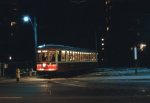


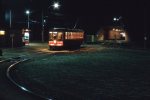
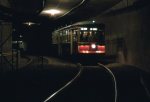





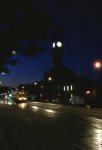

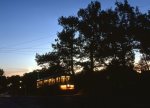

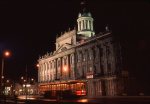



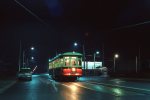


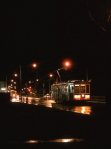
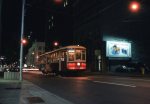






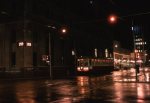
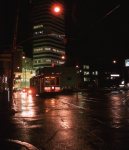


Hi Steve:-
More memories. Wow, thank you!!
My son had lived in a third floor apartment just showing above the advance light in your view of 2424 at night in front of the El Macombo. Not only the Rolling Stones played there, but my son Neil’s bands have as well.
This stretch of track probably had the worst maintained joints in the TTC’s history, mind you, Yonge north of Eglinton in the last years may have rivaled it, but I was too young for that one. Great sounds for the trolley fan with the banging and gear howl reverberating off of Spadina’s buildings.
I’ve fired the pic off to my son for his archives. Thanx again and Happy New Year Steve.
Dennis Rankin
LikeLike
Wow thanks for installment II Steve. It’s a reminder of how much the city has changed. And seeing the shots of the Witt in front of old buildings lets one imagine what it looked like even further back.
LikeLike
Happy New Year, Steve.
Dare I say it, this photoset is better (to my eyes) than the previous ones. Maybe it’s the idea of Peter Witt cars operating in the 1970s that makes me smile. Amazing how long they (and the PCCs) lasted. I wonder how many CLRVs will still be on the rails in 30 more years?
A few years ago, Spacing wrote about Melbourne’s tram-restaurant and suggested that perhaps Toronto could do something similar. Of course, a moving restaurant might not work in Toronto, but how about a stationary one? There are many examples of old streetcars used as diners (including the Superburger at Hurontario and Hwy 89 just east of Shelburne).
Imagine one of the old streetcar loops in Toronto set up with a CLRV, PCC and Peter Witt streetcar all converted to restaurants … maybe called “The Loop” or “Streetcar Square” 🙂
Cheers, Moaz
Steve: There were two old cars set up as a restautant in McCaul Loop as part of the Village by the Grange. The business didn’t last at least in part because of location (off of Queen West and not too visible) and, as I understand it, indifferent food. It went through a few changes of hands, but is long gone. There was also a PCC on the north side of Dundas just west of Yonge that operated as a store for a while, but it vanished under the Atrium on Bay development.
LikeLike
Grand memories, many thanks!!
I have been away from TO for more than 30 years, and want to preserve the great transit system in my mind…
LikeLike
Well-captured images of what used to be familiar locations. Thanks for your efforts to create those scenes and the memories evoked.
LikeLike
Nice shots sir, I don’t care what the resolution, but do you have shots of any of these ‘rare’ locations in the daylight? or were the charters mainly at night?
Steve: Running onto the tail tracks was mainly the preserve of night charters which didn’t have to deal with too much traffic. I have daytime shots of various cars in Hillside Wye, but I think that’s about it.
The resolution of the published shots is chosen to be ok for screen viewing without giving away a high res view for bandwidth and copyright reasons.
LikeLike
Happy New Year!
They can’t be used because the current vehicles are too long for them?
Steve: Kipling and Bingham now have track but no overhead. At Neville, Main and Hillside, the track has been removed. Bingham tail track comes out in 2013. CLRVs would fit on these tail tracks easily, and ALRVs on some.
LikeLike
Re streetcar restaurants. I remember also La Pentola on Eglinton East had a car as part of their restaurant complex and of course, the three (?) PCC’s that were part of the Langford Inn Restaurant on Hwy 2 between Ancaster and Brantford. I believe one of the survivors from there is the hulk on a farm on Hwy 6 near Puslinch. I was trying to remember if the Village By the Grange restaurant featured an Ottawa car???
ps-I found an internet report saying the two cars at the Village by the Grange were ex-TRC cars (???) and are still there, although hard to recognize due to constant rebuildings of the food areas at the complex.
Steve: Yes, one of the cars at McCaul Loop was ex-Ottawa.
LikeLike
Hi Steve and Mike Lindsay:-
The two cars that had been at the Village by the Grange I believe are long gone. If anything remains it may be the concrete footing that they rested on. One car was Small Witt 2806. It had been privately owned after its retirement and was subsequently donated to the Ontario Electric Railway Historical Association for parts. I think its trucks are the ones under North Yonge 416 for now, until a set of Taylors can be rebuilt to finish that car’s restoration. Once 2806 was stripped, it was fortuitous that the restaurant development was looking for a body and it then returned to TO for one last time for the restaurant. The other was an Ottawa 800 rescued from a scrap yard across the river in Quebec. The number escapes my memory but I have it recorded somewhere in my paper archives.
Yes Steve the food was indifferent, probably the site’s main reason to no longer be.
As to roving restaurants, Christchurch NZ had one that was an ex Melbourne car on their historic tramway. The web site for the tramway had had a menu. Twasn’t an inexpensive affair but I gather it recovered its costs. I haven’t checked, but it may be running again. In researching the aftermath of the earthquake there, it seems the tramway and its cars suffered very little damage. There was construction of an extension to the SE underway at the time of the disaster and I wonder if they’ve had the time to get back at it?
Dennis Rankin
Steve: According to their website, the trams are to return to Christchurch in mid-2013. The restaurant is closed, and the site does not indicate whether it will reopen concurrently with the rest of the system. Its operating period is from June through August, and so it is conceivable that it will be back this year too.
LikeLike
The tailtracks have always been somewhat of a curiosity to me. They were clearly constructed with a function in mind (presumably storage, and at some locations dump tracks). How did they become obsolete/unneeded? Were they ever truly needed enough to justify the cost of their original construction, or were they more of a relic of the grand old era of railway Engineering where the inclusion of sidings at key locations might have just been ‘common practise’?
Steve: A common use for the tail tracks in their latter years was a place to store dead cars rather than having to push them all the way back to a carhouse. However, with fewer and fewer useful locations and the fact that one would have to go out of one’s way to actually use them, they have been gradually abandoned.
Some of them such as at Neville were remnants of the wye that ended this line before the loop was built. The ones formerly at what are now Broadview Station and Dundas West Station are remnants of old track layouts. At Broadview, Erindale Loop was a block north and the cars ran north on Broadview to reach it. This tail track was removed when a runaround track (also since removed) was installed at Broadview Station. At Dundas West, streetcar service continued north and west on Dundas. Similarly, track extended east on Kingston Road from Victoria Park to Birchmount as part of the city system, and beyond as a radial line.
LikeLike
Steve wrote:
Not a problem Steve. Was only asking as years ago I bought some photos from JFB of a snowplow on KR tail east of VicPark (daytime), and a charter car on MacLean south of Queen (again in the day) and also on Neville south of Queen, so it was only the tail at Main Street I have never seen in daylight. That’s why I was wondering if you ever caught that.
Anyways happy new year, fabulous shots and looking forward to more of your analysis and commentary this year. Between the Ford ‘screw-up’, the Dalton ‘screw-up’ and Ottawa just being plain ‘screwed-up’ it should be an interesting year sir.
Steve: I think I may have some daytime shots of Neville tail track, but Maclean (originally track leading south to Scarborough Beach Park and Carhouse in the TRC days) is before my time as a charter trip rider/photographer.
LikeLike
On the subject of tail tracks, why was the inclusion of tail tracks so important to be included on the Transit City design for Weston/Mt.Dennis stop/station, and other terminals? If they are to be included the light and heavy rail lines, they should be included on streetcar lines.
Disabled streetcars now have to towed or pushed to their barns, or parked on a downtown side-street, like Church, Richmond, Adelaide, etc..
Steve: The TTC wanted not just a tail track, but a farside turnback capability at the end of any underground (ATO) running. Also, having tail tracks beyond terminal stations (e.g. Weston as it will be for a time) allows cars to enter the platforms at regular speed most of the time.
If a streetcar needs to be pushed out of the way, there are far more locations on sidestreets with trackage than there are loops.
LikeLike
Given that I’m not a Toronto resident and haven’t been there far a good many years, are there any tail tracks left at all, especially ones with both track and wire still there? You’ve mentioned Kipling not having wire, were you referring strictly to the tail track or is there no wire at all at that loop?
Steve: Kipling Loop is still active, just not its tail track. Other examples remaining on the system are few:
Bingham Loop’s track will be removed this year. There is a tail track within Woodbine Loop but it is non-clearance for CLRVs because of swingout problems. I believe this location too has no overhead.
LikeLike
The only tail track that I can think of that still has overhead is the short stretch of track east on Adelaide from Charlotte, though I’m guessing the switch is probably plugged.
Steve: I didn’t count this as a “tail track” because of the uncertainty about reopening and rebuilding the eastbound track along Adelaide. Charlotte Loop is up for replacement in the next few years, and we will see whether the switch remains or disappears.
LikeLike
In the mid-1980s I actually came across a disabled streetcar (I remember it was #4417) parked on the tail track on Main St. just north of the subway station. It’s the only time that I’ve actually seen one in use other than for posed photos on charters.
LikeLike
Re: tail tracks.
By chance, I saw a CLRV using the Gunns Loop tail track on 2006/05/26 about 4 pm. Perhaps this was the last use of that tail track, or at least among the last. The CLRV had stopped for a while for no obvious reason under the railway bridge near Keele before proceeding to the tail track.
In a sense, there is a northbound tail track on Victoria between Richmond and Adelaide. It still has overhead until the section insulator near Adelaide. To use it would require an awkward movement in reverse across Richmond.
Steve: I think we are reaching here given that this is not a purpose-build piece of track, or one deliberately left in place after a reconstruction project.
LikeLike
I understand that the Peter Witt car must always be accompanied by a more modern streetcar whenever it runs in the streets these days. I understand the reason to be the absence of rear lights. Is that correct? The rear-end Witt shot at Long Branch shows no illuminated rear-end red lights and the shot at Roncesvalles Carhouse shows only 1 center red light illuminated. Was this the brake light?
Thanks for the photos.
Steve: At the rear of the Witt cars was a pair of lights that showed either red or green. The green light is on if the controller is in any of the power positions, and red otherwise.
LikeLike
Richard L said:
That reminded me of the time a saw a disabled hybrid bus parked in the same location with the engine door propped open. Unfortunately the cellphone photos are rather grainy. I suspect this was the very last ‘use’ of the tail track. Though not the track itself, at least in the true spirit.
LikeLike
Thanks for this interesting post Steve. Long Branch Loop’s shelter definitely looks better now to me (for example, there is a window now beside the door at the east end, which allows more light in.)
One question about the tail tracks at loops – especially Kipling. As Kipling wasn’t the end of the line – it was, and is, only used to short turn cars – why wouldn’t the TTC simply have pushed a broken down car around Kipling Loop and continued back to Roncesvalles? I could somewhat understand the desire for not doing this if you were at the end of a route, but Kipling is not.
Also, in general wouldn’t ‘storing’ a broken down streetcar in a tail track eventually have to be picked up anyway – either for the first time (if it made it to the tail track on its own) or picked up again (if another streetcar pushed it there to begin with)?
Steve: Your argument certainly explains why the tail tracks have been systematically removed from the network over the years. Why they were once thought useful has been lost in the mists of time.
LikeLike
In response to TorontoStreetcars
Perhaps it’s the ‘era’ and the subsequent service levels that once made tail-tracks very useful?
From my service summary, Apr 1959, QUEEN cars ran every 1 1/2min – 40 RH vehicles looped Neville in an hour (21 in midday) compared to today, QUEEN cars (supposedly) run close to every 6min so (supposedly) about 10 RH vehicles loop Neville every hour. (close to 9 in midday)
You can see a slight bit of difference when one vehicle breaks down and clogs the line in the past compared to today.
LikeLike
I know this isn’t “tail track” related – but since Adelaide/Charlotte’s switch was brought up… i do have a question…
What is the deal with the plugged switch at Broadview & Queen? Surely this west to north curve would help deal with issues, no?
Unless I’m nuts – and the switch isn’t plugged, and cars simply just don’t use the turn?
Steve: There have been problems with derailments on this curve. The intersection is scheduled for rebuilding in 2013, and meanwhile cars enter service to Broadview Station via Parliament and Dundas.
LikeLike
Hi Steve:-
This tail track discussion has reminded me of a fan trip we took one Sunday morning and we had a photo stop at the Main St tail. It pointed out a major problem. With a car there, buses could not negotiate the turn into the station loop. Another interesting problem was that there was no frog in the trolley wire, so we had to pull the pole and coast the car in and out of the tail. A number of weeks later a frog was installed and then within a few short months, the tail track was removed, but the frog and overhead remained for another half year or so.
I also recall a visit to Boston in the middle 70s. We had stopped at the Park Street station to watch the parade of cars flow through at the end of rush hour and bore witness to an ill car being towed out of the tail track in the centre loop. By the way, this tail track had a pit too. This was at a time when none of the Boeings had even been ordered yet and they were limping along with a badly depleted fleet of their PCCs. Repairs could not be effected quickly enough to keep the cars on the lines and what a couple of years earlier had been three car trains in scheduled service became two and possibly single cars on the same timetable. An elderly woman with a very thick New England accent was chastising the poor line inspector who was fortunate to be supervising the removal of said sick trolley. Her loud comments paraphrased, were: “When are ya gonna get rid a these caws? These old caws are junk caws! They belong in the Smithsonian!!!!!”
Ahhh, memories.
Dennis Rankin
LikeLike
Dennis Rankin said:
The phrase “Be careful what you wish for” comes to mind. She certainly got her wish, but the replacement Boeings were even more of a disaster!
LikeLike
Say, Kristian, what, if anything, do you know about the reliabily of the cars (caws!) the MBTA has gotten since to replace the Boeings?
LikeLike
Is the issue of the Witt cars requiring a coupled escort one of rear signal lights or one of electromagnetic track brakes? I had heard that it was the absence of track brakes that necessitated the escort…
Steve: I believe the track brake issue is the more important, certainly the original reason. It’s possible the HTA requirement for brake lights was something somebody thought of later. At least we don’t have a man walking with a flag in front of the car or worries that it will frighten the horses.
LikeLike
I remember seeing 2766 out on the streets in Riverside 10 years ago without escorts. I believe it might have been on its way to the Beaches Easter parade. Is this a relatively recent policy change?
Steve: 10 years ago that would have been unusual as I believe the policy has been in place for longer than this.
LikeLike
You’re actually asking about two generations in that, the first are Kinki Sharyo Type 7s, which while high floor I’ve heard nothing bad about. The AnsaloBreda Type 8s have been if anything more trouble that the Boeings so far, though they seem to be operating reasonably smoothly now.
LikeLike
The ttc has posted a tender on their website which includes details of much of the specialwork reconstruction which will take place in the near future. (Full intersection drawings near the end) I think it’s great that they are still issuing drawings referencing both PCC and Witt car (and trailer!) geometry (Page 80 and 149 respectively) dating back to the 1920’s.
Steve: You never know when someone will buy another batch of Peter Witt trains!
LikeLike
Haven’t you been reading that in a number of cities in the US they are building street car lines, NOT LRT but Street Cars. Some cities are actually looking at buying old equipment, Melbourne Class W or Milano Witt or building replicas. I am sure that the TTC is just keeping all its options open. Especially given how well Route F in San Francisco works. I can see it now, Witt trains on Queen’s Quay east and west and up the Yonge street transit mall to relieve crowding on the Yonge Subway.
The trailer could have a low centre section to make it handicap accessible. They would also have powered trucks to improve performance and a fake coal stove to provide heat in the winter. With POP the train could run with only a motor man and be competitive with the new LFLRV’s. I am surprised that the TTC didn’t think of this earlier.
LikeLike
An additional use for tail tracks was for rail work equipment to lay over or clear regular service. Elimination of rail work cars such as sweepers, ploughs, flat motors, rail grinders and so on, also reduced the need for tail tracks.
light rail guy
LikeLike